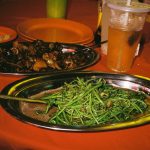Navigating Global Street Food Scenes: Top Tips for Safe Tasting Adventures
Street Food and Dietary Restrictions
Enjoying street food while maintaining dietary restrictions can be achieved with the right approach. From finding vegetarian and vegan delicacies to ensuring safety with food allergies, catering to specific dietary needs enhances the street food experience.
Finding Vegetarian and Vegan Options
Travelers seeking vegetarian or vegan street food have many delicious options available worldwide. In India, for instance, the prevalence of vegetarianism makes it easier to find plant-based dishes. Street vendors offer traditional items like samosas, dosas, and aloo tikki, often ensuring they are free of animal products.
In Thailand, dishes like som tam (papaya salad) and pad Thai can often be found without fish sauce or meat, though confirming with the vendor is essential. Latin American countries, such as Mexico, offer vegan-friendly options like tacos with grilled vegetables and salsas that can be enjoyed without cheese or cream.
Language barriers can be a challenge, so learning key phrases can help in conveying dietary needs. Understanding local terms for vegetarian or vegan can prevent confusion and ensure a satisfying culinary experience. Using translation apps or carrying cards with dietary preferences in the local language can also help. Flexibility and a willingness to try new dishes can make finding delightful plant-based street food simpler and more enjoyable.
Navigating Food Allergies
Ensuring safety while trying street food with food allergies requires preparation and vigilance. Allergy-prone travelers should research local cuisines to identify common allergens present in dishes. For those with peanut or tree nut allergies, regions where these ingredients are prevalent, such as Southeast Asia, demand extra caution.
Bringing allergy cards that clearly state the specific allergens in the local language can be invaluable. Engaging with vendors to understand the ingredients used in dishes further helps mitigate risks. In cities like Tokyo, street vendors are often accommodating and aware of allergens, which can ease communication.
Cross-contamination poses another risk, so choosing vendors who maintain good hygiene is crucial. Observing how food is prepared and asking about cooking practices can prevent exposure to allergens. Preparedness and open communication with vendors allow travelers with food allergies to safely enjoy diverse street food scenes.
Incorporating Street Food into Your Travel Itinerary
Integrating street food into travel plans can enhance the experience by providing authentic culinary discoveries. Timing meals around bustling markets and popular vendors can make the adventure more rewarding and memorable.
Planning Around Meal Times
Traveling involves managing a variety of activities, but it is important to align meal times with local dining customs for a genuine experience. Different cultures often eat at varied times, so researching local habits can ensure that travelers hit the peak times when street food is fresh and vendors are most active.
By planning breakfast, lunch, and dinner around street food markets, tourists can savor fresh dishes in their most authentic forms. Exploring food stalls in the early morning might provide access to unique breakfast delights. Likewise, lunchtime can be an ideal moment for tourists to witness the vibrant rush of locals enjoying their midday meals. Evenings are perfect for indulging in snacks and interacting with street vendors eager to share dinner specials.
Combining Sightseeing and Dining
Street food markets are frequently positioned near popular attractions, allowing for a seamless blend of sightseeing and culinary exploration. Travelers can enhance their itineraries by scheduling visits to landmarks around these locations and enjoying a delightful meal after exploring a site.
Visiting a historic site or famous landmark often offers a chance to try regional specialties unique to that area. As they stroll through a traditional market or an iconic neighborhood, travelers can uncover unexpected treats. This approach not only makes the most of time but also enriches the cultural experience. By combining cultural landmarks with culinary stops, travelers engage in a more holistic, enjoyable journey.



